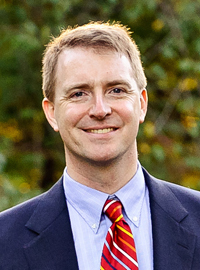CIRCL perspectives offer a window into the different worlds of various stakeholders in the cyberlearning community — what drives their work, what they need to be successful, and what they think the community should be doing. Share your perspective.
Stephen Gilbert is an Associate Director of the Virtual Reality Application Center at Iowa State University and a Professor in Industrial Engineering. His interests include in intelligent tutoring systems, usability, and the learning sciences.
(Read Stephen’s full perspective below, or watch video excerpts from the interview, which took place January 27, 2015, at Cyberlearning 2015.)
How did you get into cyberlearning?
When I was a graduate student, the Web arrived, and it distracted me heavily from my actual research. And I decided to shift and to be interested in cyberlearning. Since then, I’ve done everything from develop intelligent tutoring systems, to develop software that can improve people’s performance while they’re at work, and study it all so that we can get more kids to learn.
Tell us about your research and your work now?
I have two factors in my research. Some is on basic research about how people learn from technology. What can I do with games and with teams? How can I influence better learning? The other is for industry, which you might call training, but really, I think of it as enhancing performance for the Army, for John Deere tractor drivers, for Boeing pilots—we’re going to increase people’s performance by helping them reduce cognitive load.
As an attendee of the CL15 Meeting, what do you find exciting about cyberlearning?
Cyberlearning is particularly exciting for me right now because of the growth of sensors that we can put on your body. So I predict in five years we’ll be wearing a lot more gadgets on our body, collecting all sorts of data. And right now is the perfect time to do that, because we have new data analytics to analyze that enormous amount of data. In a recent study I did, we put a bracelet on people to measure electrodermal activity, to measure stress and arousal while people are learning. And these sorts of data give us some good insights.
The term embodied cognition has been around for awhile, and it’s being now adapted in this educational field into embodied learning, and we want to get our whole bodies involved. When you look at traditional educational software, it’s usually been on a desktop, but I’d like to learn with my whole body. I want to learn when I’m in a workshop; I want to learn when I’m out in the field doing something with other people on a team. And with the new technologies that we have, we can actually measure that.
In your observation of looking at cyberlearning technologies, which are the technologies that you feel like have the most potential to be successful?
Okay. So right now in 2015, I’m teaching freshman programming. And these students come in, and many of them don’t even know what a file is, because they have iPads that don’t use files, and they have email, and they have—and they don’t really understand what a file is. So the actual content that we’re teaching them will change—it will always be changing. But what underlies it all is the problem solving abilities and the relationships that we have with the technology that we live with.
Today, more than ever before, we’re living with the technology, and there’s a growing field of human system interaction. There are even studies of machine etiquette—you know, how should the machines be more human so that we can better interact with them? These are the ideas that are going to be taking us forward in the future, because we’re going to be constantly having to build those relationships.
What are your thoughts about ways that innovation can spread?
So, I spent a lot of time in New England, living in Boston and Cambridge, going to school. I’ve spent a lot of time in Silicon Valley, and now I’m in Iowa, in the Midwest. And what I’m really struck by, besides the fact that everybody in Iowa is nice, is the fact that it is so hard to transfer innovation, right?
You might argue that the innovation starts in one of the –, and how long will it take to reach that rural school district that my kids might be attending, right? And even in a college town where the kids are all faculty kids, so they’re smarter, the schools are better—the practice is not going to change. It’s going to take a long time for the practice to change unless groups like CIRCL put it out there, make it out there; you know, get it to change.
If ten million dollars were invested for a new research center in cyberlearning, what questions would you want the center to focus upon?
I think a great center for CIRCL would be to have a data cloud center about student learning. And we’re going to study—I think a great center for CIRCL would be to have a great data cloud, in which we capture all the information from people who are learning. We can have a game data cloud and study educational games and all the people’s performance in it; we can have a cloud of all the assessment data we have from Maker events and from educational software. And we will work with industry, for example, who’s making these games, go come up with standard protocols, so that we can all benefit from each other’s data.

